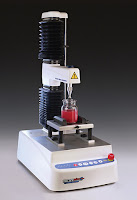When creating your optimum test method for texture/physical property measurement you will need to make choices on each of the setting values according to the type of test you have chosen. The values will depend heavily on the sample.
Pre-test speed
The probe begins to move from its start point towards the sample at the pre-test speed.
When trying to find a trigger force your pre-test speed should really not exceed 3mm/sec for best initial data capture and the most accurate starting point. A fast approach can lead to a late trigger (or ‘overshooting’) therefore entering the sample before data is being collected. Usually the pre-test speed is slower than the test speed.
- Sample hardness - a very hard sample may require a slightly higher trigger force.
- Sample softness - a very soft sample probably needs a very low trigger force.
- Probe size – you will need to consider the increased contact area.
- Whether the sample has a flat surface or not. An uneven surface may cause an early trigger.
- The load cell that is installed in your Texture Analyser may have an effect on the success of trigger force you wish to find.
A button trigger is often chosen when testing products of differing heights or very thin materials e.g. granules, or bulk compression tests.
The probe/fixture should be calibrated and the starting point of the test must remain the same each time.
Choosing a button trigger avoids, for example, touching the base of the Texture Analyser when using a knife blade.
Tests are performed to the same distances of compression with respect to the surface you have calibrated the probe against.
How to use a Button trigger?
Calibrate the probe and return to the required starting point of the test. You can save this position as Position 1 within the probe control window for quick positioning between tests.
When choosing the distance of compression choose a distance smaller than that between the base and the starting position (therefore the probe/blade will not overload by touching the base)
Data acquisition rate
Or if you have lost it, request a 167 page (pdf) in-depth manual to be sent to you.
There is a Texture Analysis test for virtually any physical property. Contact Stable Micro Systems today to learn more about our full range of solutions.
For more information on how to measure texture, please visit the Texture Analysis Properties section on our website.
The TA.XTplusC Texture Analyser is part of a family of texture analysis instruments and equipment from Stable Micro Systems. An extensive portfolio of specialist attachments is available to measure and analyse the textural properties of a huge range of food products. Our technical experts can also custom design instrument fixtures according to individual specifications.
No-one understands texture analysis like we do!
Get in touch to discuss your specific test requirements
 |  |  |











No comments:
Post a Comment